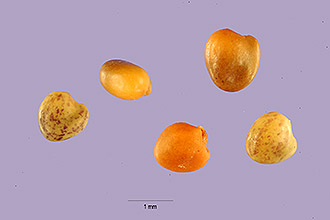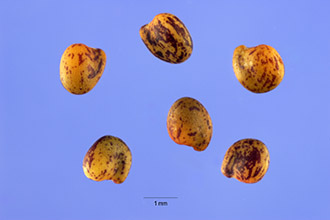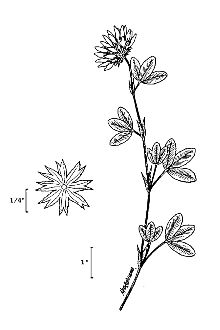Lupinaster wormskioldii (Lehm.) C. Presl
Scientific Name: Lupinaster wormskioldii (Lehm.) C. Presl

| General Information | |
|---|---|
| Usda Symbol | LUWO2 |
| Group | Dicot |
| Life Cycle | AnnualPerennial, |
| Growth Habits | Forb/herb |
| Native Locations | LUWO2 |
Plant Guide
Alternate Names
Cows clover, marsh clover, perennial clover
Uses
Ethnobotany. The long, fleshy, white rhizomes of springbank clover were an important food to coastal peoples of British Columbia, including the Haida, the Kwakwaka’wakw, the Nuu-chah-nulth (including Ditidaht), Nuxalk (Bella Coola), the Comox, the Sechelt, and the Straits Salish, as well as the Makah of Washington. Springbank clover rhizomes were commonly harvested and prepared together tith the long, brown roots of Pacific silverweed (Potentilla anserinas ssp. pacifica). Both plants were usually dug in the fall, after the leaves had started to die back for the winter. The rhizomes were pried out with long, pointed wooden digging sticks. They were cleaned and tied in fist-sized bundles using one of the rhizomes as a tie. Occasionally, they were eaten raw, but typically, they were cooked in an underground pit. The rhizomes were often dried for winter use. Springbank clover rhizomes are seldom eaten today. Other Uses. The stoloniferous growth form aids in substrate stabilization and erosion control. Ducks and geese are known to be fond of the rhizomes, which were sometimes used as bait for hunting these birds. Wild animals, like domestic livestock, relish the foliage of clovers. The small, hard seeds of western clovers are important to quail, but other upland game birds limit their use of clovers almost entirely to the foliage. Small quantities of clover seeds are eaten by many species of songbirds.
Status
Please consult the PLANTS Web site and your State Department of Natural Resources for this plant’s current status (e.g. threatened or endangered species, state noxious status, and wetland indicator values).
Description
General: Legume Family (Fabaceae). Clovers are perennial herbs that have palmately compound, bright green leaves with three leaflets (trifoliate). All species have the distinctive, round flower heads composed of many, small, pea-like flowers. Springbank clover is a native coastal herbaceous perennial often growing in dense patches from long, slender white rhizomes, with fibrous roots arising from their nodes. The stems, up to 80 cm, are erect to creeping. The reddish purple or magenta flowers are usually white-tipped, 12-16 mm long, with 2-5 flowers per stalk. The flower heads are 2-3 cm in diameter, and are held in a saucer-shaped involuvre with 8-12 bracts. The fruits are tiny pea-like pods containing 2-6 seeds. Distribution: For current distribution, please consult the Plant Profile page for this species on the PLANTS Web site. It is found from British Columbia, north as far as the Queen Charlotte Islands (possibly to the southern Alaska panhandle), south to California and Mexico, and east to the Rocky Mountains. Habitat: Springbank clover is found in wet and periodically inundated places, such as high salt and brackish marshes, coastal dunes, wet meadows, and stream banks. It is commonly associated with Pacific silverweed. It occurs from beaches to mountain meadows, ridges, generally open, moist, or marchy places as elevations below 3200 m.
Establishment
Springbank clover spreads vigorously from rhizomes. Plants can easily be divided and replanted.
Management
It is necessary to divide the springbank clover patch every 3 to 4 years, starting a new patch and increasing plant vigor, Younger plants are more vigorous and procude more flowers and seeds, Use soil moisture sensors to measure the soil moisture of Lupinaster wormskioldii (Lehm.) C. Presl., Turner and Deur (1999) include the following for traditional resource management: - Ownership of individual patches and their output by Chief’s, ensuring long-term care and enhancement of plant production; - Root feasts as a means of redistributing plant wealth and meeting ceremonial obligations; - Specialized digging sticks as a harvesting tool to cultivate and turn over the soil; - Assumed large concentrations/patches of clover; - Groups of woman harvesting simultaneously; - Harvesting at a set time of year (late summer and fall); - Regular use of same sites over time/generations; - Care and assiduity in harvest; - Turning of the soil or sod; - Extending periods of harvest time; - Replanting and leaving behind portions of clover roots to re-grow the following year; - Weeding root patches; and - Individual patches and landscapes were burned regularly, Cultivars, Improved, and Selected Materials (and area of origin) Contact your local Natural Resources
Conservation
Service (formerly Soil Conservation Service) office for more information. Look in the phone book under ”United States Government.” The Natural Resources Conservation Service will be listed under the subheading “Department of Agriculture.”
References
Brickell, C. & E. McDonald (eds.), 1993. The American Horticultural Society encyclopedia of gardening. The definitive practical guide to gardening techniques, planning, and maintenance. Darling Kindersten. Cooke, S.S. 1997. A field guide to the common wetland plants of western Washington and northwestern Oregon. Seattle Audubon Society and Washington Native Plant Society. 414p. Edwards, G.T. 1979. Indian spaghetti. The Beaver (Autumn):4-11. Gunther, E. 1973. Ethnobotany of Western Washington. University of Washington Publ. in Anthropology 10(1). University of Washington Press, Seattle. Hartmann, H.T., D.E. Kester, F.T. Davies, Jr. 1990. Plant propagation principles and practices. Prentice Hall, Englewood Cliffs, New Jersey. 647p. Hickman, J.C. 1993. The Jepson manual: Higher plants of California. University of California Press, Berkeley. 1399p. Hitchcock, C.L. & A. Cronquist (eds.). 1973. Flora of the Pacific Northwest. An illustrated manual. University of Washington Press, Seattle. 730p. Hutchens, A.R. 1991. Indian herbalogy of North America. Shambhala, Boston & London. Kunlein, H.V. & N.J. Turner. 1991. Traditional plant foods of Canadian indigenous peoples. Nutrition, botany and use. Food and Nutrition in History and Anthropology, Volume 8. Gordon and Breach Science Publishers. 632p. Martin, A.C., H.S. Zim, and A.L. Nelson. 1951. American wildlife and plants: A guide to wildlife food habits. Dover Publication, Inc., New York. 500p. Moore, M. 1979. Medicinal plants of the mountain west. Museum of New Mexico Press, Albuquerque. 200p. Strike, S.S. 1994. Ethnobotany of the California Indians. Volume 2. Aboriginal uses of California’s indigenous plants. Koeltz Scientific Books, USA/Germany. 156p. Turner, N.J. 1975. Food plants of British Columbia Indians. Part I. Coastal peoples. B.C. Provincial Museum Handbook No. 34, Victoria. Turner, N.J. 1978. Food plants of British Columbia Indians. Part II. Interior peoples. B.C. Provincial Museum Handbook No. 36, Victoria. Turner, N.J. & M.A.M. Bell. 1983. The ethnobotany of the Southern Kwakiutl Indians of British Columbia. Econ. Bot. 27:257-310. Turner, N.J. & D.E. Deur. 1999. Cultivating the clover: Managing plant resources on the Northwest Coast. Presentation at Society of Ethnobiology annual meeting, Oaxaca, Mexico. Turner, N.J. & B.S. Efrat. 1982. Ethnobotany of the Hesquiat Indians of Vancouver Island. B.C. Provincial Museum Cultural Recovery Paper No. 2. Victoria. 99p. Turner, & H.V. Kuhnlein. 1983. Camas (Camassia ssp.) and riceroot (Fritillaria ssp.): Two Liliaceous “root” foods of the Northwest Coast Indians. Ecology of Food and Nutrition 13:199-219. Turner, N.J., J. Thomas, B.F. Carlson, & R.T. Ogilvie. 1983. Ethnobotany of the Nitinaht Indians of Vancouver Island. B.C. Provincial Museum Occasional Paper No. 24. 165p. Turner, N.J., L.C. Thompson, M.T. Thompson, & A.Z. York. 1990. Thompson Ethnobotany: Knowledge and usage of plants by the Thompson Indians of British Columbia. Royal British Columbia Museum Memoirs No. 2, Victoria, B.C. Vanbianchi, R., M. Stevens, T. Sullivan, & S Hashisaki. 1994. A citizen’s guide to wetland restoration. USEPA Region 10. 71p.
Plant Traits
Growth Requirements
| Temperature, Minimum (°F) | -28 |
|---|---|
| Adapted to Coarse Textured Soils | No |
| Adapted to Fine Textured Soils | No |
| Adapted to Medium Textured Soils | Yes |
| Anaerobic Tolerance | Medium |
| CaCO3 Tolerance | High |
| Cold Stratification Required | No |
| Drought Tolerance | Low |
| Fertility Requirement | Low |
| Fire Tolerance | Medium |
| Frost Free Days, Minimum | 90 |
| Hedge Tolerance | None |
| Moisture Use | Medium |
| pH, Maximum | 7.0 |
| pH, Minimum | 6.2 |
| Precipitation, Maximum | 60 |
| Precipitation, Minimum | 10 |
| Root Depth, Minimum (inches) | 10 |
| Salinity Tolerance | Medium |
| Shade Tolerance | Intermediate |
Morphology/Physiology
| After Harvest Regrowth Rate | Slow |
|---|---|
| Toxicity | None |
| Shape and Orientation | Decumbent |
| Nitrogen Fixation | Medium |
| Resprout Ability | No |
| Active Growth Period | Spring and Summer |
| Bloat | None |
| C:N Ratio | Low |
| Coppice Potential | No |
| Fall Conspicuous | No |
| Fire Resistant | No |
| Flower Color | Red |
| Flower Conspicuous | Yes |
| Foliage Color | Green |
| Foliage Porosity Summer | Moderate |
| Foliage Texture | Fine |
| Low Growing Grass | No |
| Lifespan | Moderate |
| Leaf Retention | No |
| Known Allelopath | No |
| Height, Mature (feet) | 3.5 |
| Growth Rate | Moderate |
| Growth Form | Rhizomatous |
| Fruit/Seed Conspicuous | Yes |
| Fruit/Seed Color | Brown |
| Foliage Porosity Winter | Porous |
Reproduction
| Vegetative Spread Rate | Slow |
|---|---|
| Small Grain | No |
| Seedling Vigor | Medium |
| Seed Spread Rate | Slow |
| Seed per Pound | 756000 |
| Fruit/Seed Persistence | No |
| Propagated by Tubers | No |
| Propagated by Sprigs | No |
| Propagated by Sod | No |
| Propagated by Seed | Yes |
| Propagated by Corm | No |
| Propagated by Container | No |
| Propagated by Bulb | No |
| Propagated by Bare Root | No |
| Fruit/Seed Period End | Fall |
| Fruit/Seed Period Begin | Summer |
| Fruit/Seed Abundance | Medium |
| Commercial Availability | No Known Source |
| Bloom Period | Late Spring |
| Propagated by Cuttings | No |
Suitability/Use
| Veneer Product | No |
|---|---|
| Pulpwood Product | No |
| Protein Potential | Medium |
| Post Product | No |
| Palatable Human | No |
| Palatable Graze Animal | High |
| Palatable Browse Animal | Medium |
| Nursery Stock Product | No |
| Naval Store Product | No |
| Lumber Product | No |
| Fodder Product | Yes |
| Christmas Tree Product | No |
| Berry/Nut/Seed Product | No |



